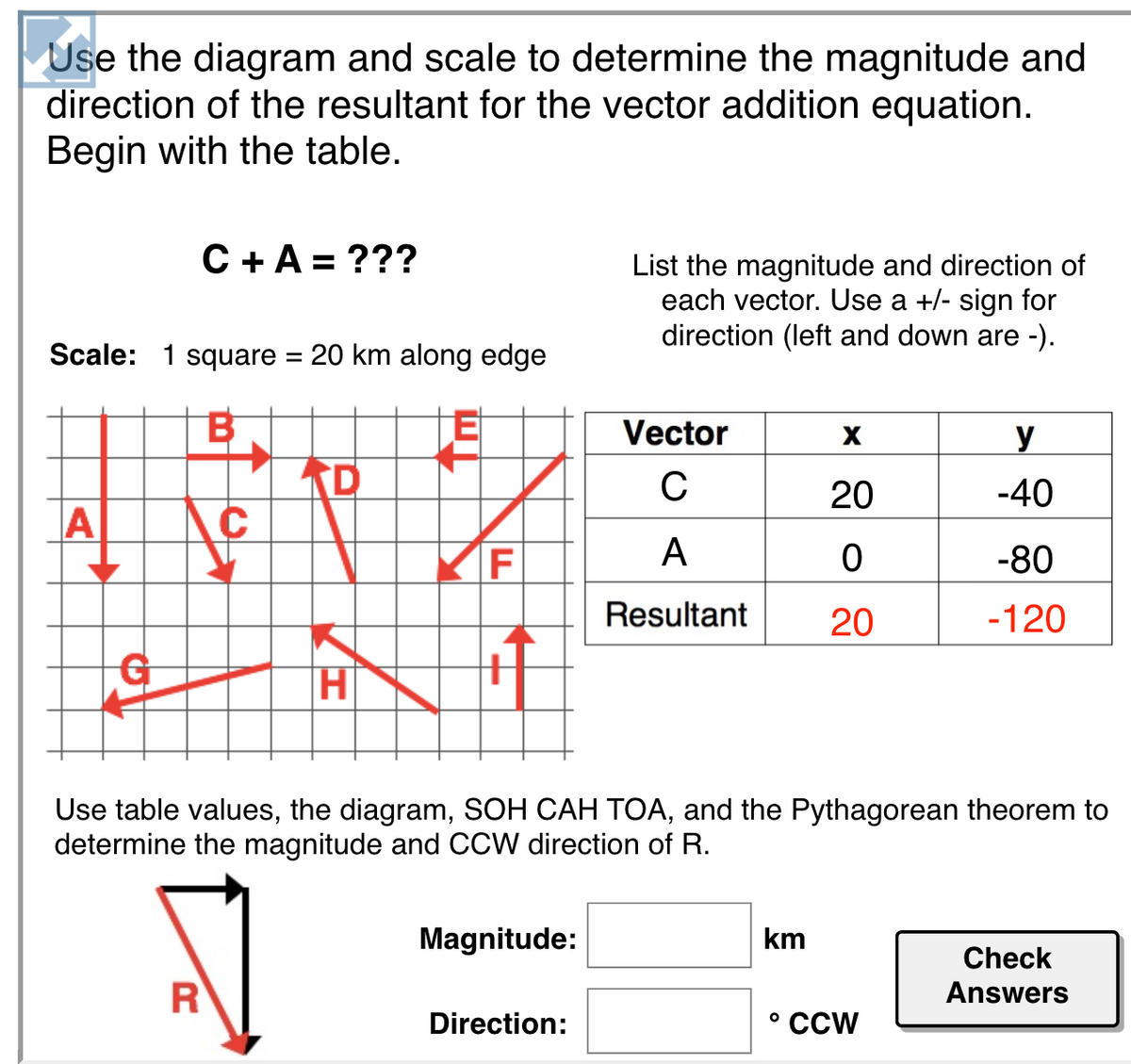Use the diagram and scale to determine the magnitude and direction of the resultant for the vector addition equation. Begin with the table. C+A = ??? List the magnitude and direction of each vector. Use a +/- sign for direction (left and down are -). Scale: 1 square = 20 km along edge %3D Vector y TD C 20 -40 A A -80 Resultant 20 -120 Use table values, the diagram, SOH CAH TOA, and the Pythagorean theorem to determine the magnitude and CCW direction of R. Magnitude: km Check R Answers Direction: ° CCW
Use the diagram and scale to determine the magnitude and direction of the resultant for the vector addition equation. Begin with the table. C+A = ??? List the magnitude and direction of each vector. Use a +/- sign for direction (left and down are -). Scale: 1 square = 20 km along edge %3D Vector y TD C 20 -40 A A -80 Resultant 20 -120 Use table values, the diagram, SOH CAH TOA, and the Pythagorean theorem to determine the magnitude and CCW direction of R. Magnitude: km Check R Answers Direction: ° CCW
University Physics Volume 1
18th Edition
ISBN:9781938168277
Author:William Moebs, Samuel J. Ling, Jeff Sanny
Publisher:William Moebs, Samuel J. Ling, Jeff Sanny
Chapter2: Vectors
Section: Chapter Questions
Problem 50P: A small plane flies 40.0 km ma direction 60 north of east and then flies 30.0 km in a direction 15...
Related questions
Question
Practice Pack

Transcribed Image Text:Use the diagram and scale to determine the magnitude and
direction of the resultant for the vector addition equation.
Begin with the table.
C +A = ???
List the magnitude and direction of
each vector. Use a +/- sign for
direction (left and down are -).
Scale: 1 square
20 km along edge
垣
D
Vector
y
20
-40
F
A
-80
Resultant
-120
Use table values, the diagram, SOH CAH TOA, and the Pythagorean theorem to
determine the magnitude and CCW direction of R.
Magnitude:
km
Check
R
Answers
Direction:
° CCW
20
Expert Solution
This question has been solved!
Explore an expertly crafted, step-by-step solution for a thorough understanding of key concepts.
This is a popular solution!
Includes step-by-step video
Trending now
This is a popular solution!
Learn your way
Includes step-by-step video
Step by step
Solved in 2 steps with 2 images

Knowledge Booster
Learn more about
Need a deep-dive on the concept behind this application? Look no further. Learn more about this topic, physics and related others by exploring similar questions and additional content below.Recommended textbooks for you

University Physics Volume 1
Physics
ISBN:
9781938168277
Author:
William Moebs, Samuel J. Ling, Jeff Sanny
Publisher:
OpenStax - Rice University

Principles of Physics: A Calculus-Based Text
Physics
ISBN:
9781133104261
Author:
Raymond A. Serway, John W. Jewett
Publisher:
Cengage Learning

Physics for Scientists and Engineers, Technology …
Physics
ISBN:
9781305116399
Author:
Raymond A. Serway, John W. Jewett
Publisher:
Cengage Learning

University Physics Volume 1
Physics
ISBN:
9781938168277
Author:
William Moebs, Samuel J. Ling, Jeff Sanny
Publisher:
OpenStax - Rice University

Principles of Physics: A Calculus-Based Text
Physics
ISBN:
9781133104261
Author:
Raymond A. Serway, John W. Jewett
Publisher:
Cengage Learning

Physics for Scientists and Engineers, Technology …
Physics
ISBN:
9781305116399
Author:
Raymond A. Serway, John W. Jewett
Publisher:
Cengage Learning

College Physics
Physics
ISBN:
9781285737027
Author:
Raymond A. Serway, Chris Vuille
Publisher:
Cengage Learning

Physics for Scientists and Engineers with Modern …
Physics
ISBN:
9781337553292
Author:
Raymond A. Serway, John W. Jewett
Publisher:
Cengage Learning

Glencoe Physics: Principles and Problems, Student…
Physics
ISBN:
9780078807213
Author:
Paul W. Zitzewitz
Publisher:
Glencoe/McGraw-Hill